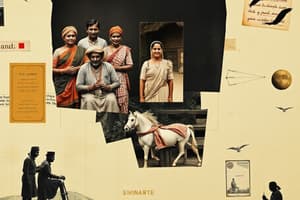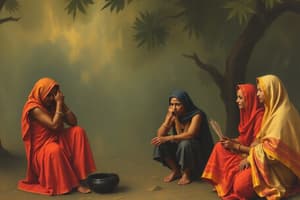Podcast
Questions and Answers
Which tribe was primarily found in western and central India?
Which tribe was primarily found in western and central India?
- Bhils (correct)
- Koragas
- Kolis
- Gonds
The Kolis were exclusively settled agriculturists by the late sixteenth century.
The Kolis were exclusively settled agriculturists by the late sixteenth century.
False (B)
Name one product nomadic pastoralists exchanged with settled agriculturists.
Name one product nomadic pastoralists exchanged with settled agriculturists.
grain
The _______ tribe was known for their traditional hunting and gathering lifestyle.
The _______ tribe was known for their traditional hunting and gathering lifestyle.
Match the following tribes with their respective locations:
Match the following tribes with their respective locations:
What did nomadic pastoralists primarily live on?
What did nomadic pastoralists primarily live on?
Mobile traders connected India with the outside world through trade.
Mobile traders connected India with the outside world through trade.
Identify one tribe mentioned that has become settled agriculturists.
Identify one tribe mentioned that has become settled agriculturists.
Who were the most important trader nomads mentioned?
Who were the most important trader nomads mentioned?
Nomads are known for their permanent settlements.
Nomads are known for their permanent settlements.
What was the name of the caravan used by the Banjaras?
What was the name of the caravan used by the Banjaras?
The Banjaras transported grain to city markets using _____ on their animals.
The Banjaras transported grain to city markets using _____ on their animals.
Match the following groups with their characteristics:
Match the following groups with their characteristics:
Which of the following was a role of the Banjaras during military campaigns?
Which of the following was a role of the Banjaras during military campaigns?
Sultan Alauddin Khalji utilized the Banjaras for transporting grain.
Sultan Alauddin Khalji utilized the Banjaras for transporting grain.
Name one type of itinerant group mentioned in the content.
Name one type of itinerant group mentioned in the content.
What was the main source of strength for the Ahoms that helped them build a large state?
What was the main source of strength for the Ahoms that helped them build a large state?
The Ahom state relied on voluntary labor for its construction projects.
The Ahom state relied on voluntary labor for its construction projects.
From which region did the Ahoms migrate to the Brahmaputra valley?
From which region did the Ahoms migrate to the Brahmaputra valley?
The Ahoms subjugated many tribes and annexed kingdoms such as the Chhutiyas in _____.
The Ahoms subjugated many tribes and annexed kingdoms such as the Chhutiyas in _____.
Match the following dates with the significant events for the Ahoms:
Match the following dates with the significant events for the Ahoms:
What was the title given to those who were forced to work for the Ahom state?
What was the title given to those who were forced to work for the Ahom state?
The Mughal control over the Ahom region was maintained for an extended period.
The Mughal control over the Ahom region was maintained for an extended period.
During which century did the Ahoms achieve the ability to make high-quality gunpowder?
During which century did the Ahoms achieve the ability to make high-quality gunpowder?
What primarily united the members of each tribe?
What primarily united the members of each tribe?
All societies in the subcontinent were structured according to the varna rules.
All societies in the subcontinent were structured according to the varna rules.
What were the main activities that tribes engaged in to obtain their livelihood?
What were the main activities that tribes engaged in to obtain their livelihood?
Some tribes were _______ and moved from one place to another.
Some tribes were _______ and moved from one place to another.
Match the following societal characteristics with their respective types:
Match the following societal characteristics with their respective types:
What was the title of the leader who united the Mongol and Turkish tribes?
What was the title of the leader who united the Mongol and Turkish tribes?
Which of the following is NOT a characteristic of tribes?
Which of the following is NOT a characteristic of tribes?
The Mongols were known primarily for their agricultural lifestyle.
The Mongols were known primarily for their agricultural lifestyle.
The hierarchy between social classes decreased under the Delhi Sultans and the Mughals.
The hierarchy between social classes decreased under the Delhi Sultans and the Mughals.
What regions did the Mongol Empire include at different points in time?
What regions did the Mongol Empire include at different points in time?
What type of societies were often called tribes?
What type of societies were often called tribes?
By 1227, Genghis Khan was the ruler of extensive __________.
By 1227, Genghis Khan was the ruler of extensive __________.
Match the following terms with their descriptions:
Match the following terms with their descriptions:
What type of society did some tribes merge with over time?
What type of society did some tribes merge with over time?
What was a significant consequence of the Mongols' political power?
What was a significant consequence of the Mongols' political power?
The Mongol Empire had poorly organized military and administrative systems.
The Mongol Empire had poorly organized military and administrative systems.
What agricultural practice did the Gond tribe engage in?
What agricultural practice did the Gond tribe engage in?
The Gond rajas retained equal social standing among all clans.
The Gond rajas retained equal social standing among all clans.
What was the primary governing structure within the Gond kingdoms?
What was the primary governing structure within the Gond kingdoms?
The Gond kingdom of Garha Katanga had approximately ____ villages.
The Gond kingdom of Garha Katanga had approximately ____ villages.
What resulted from the emergence of large states in Gond society?
What resulted from the emergence of large states in Gond society?
The power of the Delhi Sultans was increasing at the same time as large Gond kingdoms were emerging.
The power of the Delhi Sultans was increasing at the same time as large Gond kingdoms were emerging.
Who became more influential due to land grants in the Gond society?
Who became more influential due to land grants in the Gond society?
Flashcards
Tribal Societies
Tribal Societies
Societies that did not follow the social rules of the Brahmanas and were not divided into unequal classes.
Kinship Bonds
Kinship Bonds
Family ties that united members of a tribe.
Tribal Livelihoods
Tribal Livelihoods
Varied, often combining farming, hunting, gathering, and herding.
Nomad Tribes
Nomad Tribes
Signup and view all the flashcards
Social Hierarchy
Social Hierarchy
Signup and view all the flashcards
Brahmana Rules
Brahmana Rules
Signup and view all the flashcards
Economic Developments
Economic Developments
Signup and view all the flashcards
Social Change
Social Change
Signup and view all the flashcards
Settled agriculturalists
Settled agriculturalists
Signup and view all the flashcards
Nomadic pastoralists
Nomadic pastoralists
Signup and view all the flashcards
Exchanged goods
Exchanged goods
Signup and view all the flashcards
Kolis, Berads, Bhils, and Gonds
Kolis, Berads, Bhils, and Gonds
Signup and view all the flashcards
Zamindars
Zamindars
Signup and view all the flashcards
Hunter-gatherers
Hunter-gatherers
Signup and view all the flashcards
Mobile Traders
Mobile Traders
Signup and view all the flashcards
Pastoral products
Pastoral products
Signup and view all the flashcards
Banjara traders
Banjara traders
Signup and view all the flashcards
Tanda
Tanda
Signup and view all the flashcards
Nomads
Nomads
Signup and view all the flashcards
Central Asian traders
Central Asian traders
Signup and view all the flashcards
Mughal army grain transport
Mughal army grain transport
Signup and view all the flashcards
Peter Mundy
Peter Mundy
Signup and view all the flashcards
Itinerant groups
Itinerant groups
Signup and view all the flashcards
Sultan Alauddin Khalji
Sultan Alauddin Khalji
Signup and view all the flashcards
Mongol Tribes
Mongol Tribes
Signup and view all the flashcards
Genghis Khan
Genghis Khan
Signup and view all the flashcards
Mongol Empire
Mongol Empire
Signup and view all the flashcards
Organized Military
Organized Military
Signup and view all the flashcards
Caste-Based Society
Caste-Based Society
Signup and view all the flashcards
Political Power
Political Power
Signup and view all the flashcards
Nomadic Lifestyle
Nomadic Lifestyle
Signup and view all the flashcards
Conflict with Larger Kingdoms
Conflict with Larger Kingdoms
Signup and view all the flashcards
Gond Shifting Cultivation
Gond Shifting Cultivation
Signup and view all the flashcards
Gond Clan Structure
Gond Clan Structure
Signup and view all the flashcards
Garha Katanga Kingdom
Garha Katanga Kingdom
Signup and view all the flashcards
Centralized Administrative System
Centralized Administrative System
Signup and view all the flashcards
Chaurasi
Chaurasi
Signup and view all the flashcards
Social Class Division
Social Class Division
Signup and view all the flashcards
Land Grants to Brahmanas
Land Grants to Brahmanas
Signup and view all the flashcards
Gond Kingdoms Domination
Gond Kingdoms Domination
Signup and view all the flashcards
Ahom migration
Ahom migration
Signup and view all the flashcards
Ahom state creation
Ahom state creation
Signup and view all the flashcards
Ahom expansion
Ahom expansion
Signup and view all the flashcards
Ahom military strength
Ahom military strength
Signup and view all the flashcards
Ahom defeat by Mughals
Ahom defeat by Mughals
Signup and view all the flashcards
Ahom forced labor
Ahom forced labor
Signup and view all the flashcards
Ahom central administration
Ahom central administration
Signup and view all the flashcards
Ahom rice cultivation
Ahom rice cultivation
Signup and view all the flashcards
Study Notes
Tribes, Nomads, and Settled Communities
- Kingdoms rose and fell, experiencing new arts, crafts, and economic growth in towns and villages.
- Social change varied across different societies due to differing social and economic developments.
- In many parts of the subcontinent, the varna system (social hierarchy) prescribed by Brahmanas influenced the rulers of large kingdoms, leading to increased class divisions rich/poor and high/low.
- Tribal societies didn't follow the rules and rituals of the Brahmanas and weren't divided into unequal classes.
- Tribes often lived in forests, hills, deserts, or remote areas.
- Tribal members were united by kinship, and their livelihoods were diverse (agriculture, herding, or hunting and gathering).
- Tribes often combined these activities to utilize resources effectively.
- Tribes retained their freedom and cultural identity, often clashing with more powerful caste-based societies.
- Relationships between caste-based and tribal societies evolved gradually from conflict to interdependence.
- Tribal people lived in diverse regions of the subcontinent.
- Size and influence of tribes varied over time and by location.
- Some powerful tribes controlled large territories.
- Tribal people had varied livelihood strategies, including agriculture, herding, and hunting and gathering.
- Members of tribes were united by kinship bonds.
- Nomadic pastoralists moved with their animals, living on milk, and exchanged products with settled agriculturists.
- Banjaras were crucial traders, using animal caravans to transport goods (especially grain).
- The rise of Rajput clans led tribal people to gradually adopt the caste system, which caused inequality.
- Shifting cultivation was practiced by tribes such as the Gonds, involving clearing land, farming, and shifting to new areas after land fertility decline.
- Gonds lived in the vast forested region of Gondwana, establishing large kingdoms.
- Ahoms migrated to the Brahmaputra Valley and established a state from the 13th century, expanding their area politically and militarily, though they faced invasions from the south-west (Mughal invasions).
- Ahom society was divided into clans (khels) and had fewer artisan castes compared to others.
- Ahom administrative systems became centralized.
- Extensive states with well-organized administration systems emerged, leading to increased political power.
- Social change in the subcontinent involved interaction between varnas (caste system) and tribal societies.
- Variety of professions appeared and existing ones grew and spread across regions, like occupations of artisans (smiths etc.).
- Different kinds of societies evolved differently due to varied economic and social factors.
Studying That Suits You
Use AI to generate personalized quizzes and flashcards to suit your learning preferences.




